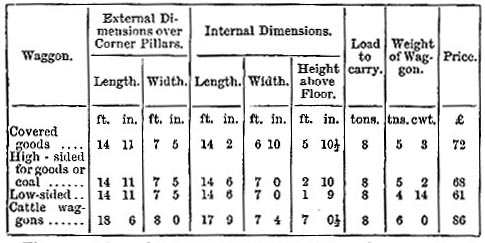G. CARRIAGES AND WAGGONS (cont.)
Recent Carriage Stock
Railway carriages are composed of two distinct parts,—the under-frame or substructure, and the body or superstructure. The under-frame has to carry the body and to resist the stress of work. It should be on axles placed well apart, and should be firmly framed together, of hard wood, with iron tie-rods, brackets, knees, straps, bolts and nuts. Powerful laminated springs are lodged within the frame to take the pull of the train through the central draw-bars and to intercept and absorb the thrusts of the buffers at the ends through the buffing-rods. On the Midland Railway four-wheeled carriages are (1885) being gradually superseded by six-wheeled and long bogie carriages. Four varieties of bogie carriage and three varieties of six-wheeled carriage are constructed for the service. First-class compartments are constructed to seat six persons, three on each side; third-class compartments seat ten persons, five on each side. A uniform width of 8 feet outside, or 7 1/2 inside, is adopted for all carriages; and, as a rule, first-class compartments are 7 1/4 feet long between the partitions, and third-class compartments 6 feet long. The roof is 7 feet 4 inches above the floor at the centre, and the clear height of the doorway is 6 feet. The wheels are 3 feet 7 1/2 inches in diameter. Leading particulars of the several kinds of carriage now constructed on the Midland Railway are given in Table XXX. as follows:—

Each of these carriages is fitted with a vacuum brake. In the beginning of 1885 there were 837 bogie carriages at work on the Midland Railway, inclusive of 34 Pullman cars. The bogie cars, in virtue of their ability to swing their bogies to the curves on the line, run more freely than ordinary carriages, which have parallel axles. Six-wheeled carriages are enabled to run the more freely by an allowance of lateral play for the axle-boxes of the middle axle between the axle-guards, whereby the wheels adapt themselves freely to the rails on curves. The Pullman cars in use on the Midland Railway were sent from America. They are of two kinds,—the drawing-room for day service and the sleeping-car. The body of the cars is 51 1/2 feet in length externally and 8 feet 9 inches wide. Inside the body is 8 feet 2 inches wide, and 8 feet 6 1/2 inches high above the floor. The total length, including the gangways at the ends, is 58 feet. Each car is mounted on two four-wheeled bogies. There are seats for twenty-seven persons in the drawing-room car, with lavatories and heating apparatus, and twenty-two beds are made up in each sleeping-car. The cars weigh 21 1/2 tons and their cost is £2700 each.
The carriage stock of the Metropolitan Railway was designed to carry large numbers. The bodies of the carriages are 39 1/2 feet in length and 8 1/2 feet wide outside, running on eight wheels, of which the extreme axles radiate, or are movable laterally to suit the curves of the way. The first-class carriages are divided into six compartments, providing seats for forty-eight passengers. The second and third class carriages have eight compartments, holding altogether eighty passengers in each. These carriages weigh 13 tons each.
The waggon stock of the Midland Railway is of several classes. All the standard goods and mineral waggons, as well as cattle-waggons, are constructed to carry 8 tons. Leading dimensions, weights, and prices are given below in Table XXXI.:—
The covered goods waggons are made with a doorway at each side, 5 feet wide and 5 high, and a sliding door to each doorway. The high-sided waggons are made with a doorway and hinged door in each side, and two trap-doors in the bottom. In the low-sided waggons each side is a door for its whole length. The cattle-waggons are made with doorways in each side, to each of which there are two doors hinged to each doorpost, and a letting-down door hinged to the lower side-rail. All the waggons are fitted with transverse buffing and draw springs.
Read the rest of this article:
Railway, Railways - Table of Contents

